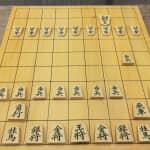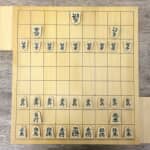17 January 2017
Shogi game for beginners–“Let’s Play Tag Chasing a King”–
We, I-tsu-tsu, held a variety of Shogi events for parents and children, or provide lectures for mothers. Taking those opportunities, we introduce a game named “Tag Chasing a King” not only for children but also for parents who are not very familiar with Shogi rules.
The rule of this game is that parents have only one piece, Gyoku (King) or Ou (King), and children try to capture the Gyoku/Ou with two pieces, Hisha (Rook) and Kaku (Bishop).

In this game, you use three types of pieces. You will learn one of Shogi rules, which is to promote a piece termed Naru in Japanese. Because you use Hisha (Rook) and Kaku (Bishop), which move a lot dynamically, you can finish the game quickly at a good pace.
If you and your children don’t have enough knowledge about the Shogi rules, you might find it difficult to play the game, “Tag Chasing a King”.
Today, I would like to give some good tips to enjoy “Tag Chasing a King”, explaining the effective techniques for parents to improve children’s skills.
Let’s have fun to play a game of tag, learning Shogi techniques.

The above picture shows a Shogi board and pieces which are used for “Tag Chaing a King” in our events.
Step 1: Make sure if you can check after understanding each piece’s reaching power.
First, children need to be familiar with how Hisha (Rook) and Kaku (Bishop) move respectively, and how each of them, Ryu (Promoted Rook) and Uma (Promoted Bishop) moves after its promotion. (When you move your piece into your opponent’s camp and turn it over, the piece will get promoted.)


In the first step, it is the most important for children to develop an awareness of capturing Gyoku (King). Parents are supposed to create a chance wisely for children to capture Gyoku (King).
There are three tips for parents to let their Gyoku (King) be captured easily:
1. In the Gyoku (King) can move upward or diagonally forward, try to move it sideways or backward.
2. Move Gyoku (King) to the corners.
3. Even though Gyoku (King) can capture children’s piece, don’t capture it.
Gyoku (King) can move one square in any direction per move forward, backward, sideways, and diagonally. I recommend moving it purposefully sideways or backward because Gyoku (King) moving forward will allow it to have more squares to move to and will make it difficult for children to capture the Gyoku (King).
Despite all efforts, if children can’t capture Gyoku (King), they might lose their interests in Shogi.
The above second tip is based on the same purpose as the first one. For example, if Gyoku (King) is at the bottom right corner, it can move only forward, left, and diagonally left. Since it can move only to three squares, it becomes easier for children to capture Gyoku (King).
The third tip goes with the same purpose. The fewer pieces children have, the more difficult it becomes for children to capture Gyoku (King).
Without these tips, it might be difficult for those who have a higher level of skills than children to lose a game purposely. I believe children come to like Shogi through experiences of capturing Gyoku (King) and winning a game.

Step 2: Check from a Position Where an Attacking Piece Is Free from Being Captured
It’s important for children to understand how Gyoku (King) is moving to keep their own pieces, Hisha (Rook) and Kaku (Bishop), from being captured. Children need to realize what the situation is. For example, they need to know which squares are covered by reaching power of Gyoku (King) and to which squares children shouldn’t move their pieces.
After that, things parents keep in mind are tip 2 and tip 3 in step 1. Children will learn where to move their pieces through the experiences of being captured.

Step 3: Check from a Position Possible for Getting a Piece Back.
In Step 2, you learned how to move your piece avoiding being captured. From now on, you need to calculate three future moves as follows:
1. The first move: You move your piece.
2. The second move: Your opponent will take the piece you moved.
3. The third move: You get a piece back with your piece.
These are three future moves you need to calculate, which is the basic Shogi technique.
The below picture shows an example of the situation in which you can get a piece back after losing your piece. When you place Ryu (Promoted Rook) and Uma (Promoted Bishop) like the picture, even though your Uma (Promoted Bishop) is captured by Gyoku (King), you can get it back with Ryu (Promoted Rook).
When you check, do it in a way to take advantage of other pieces to keep your piece, which is checking, from being captured for free. This technique is termed Himo wo Tsukeru in Japanese, which means to string. When you feel you have leeway, try to remember Shogi terminologies.
In this Step 3, things parents should keep in mind are only tip 2 and tip 3 in step 1.

Step 4: Using Invisible Beam, Keep Gyoku (King) from Escaping Upward
Hisha (Rook) and Kaku (Bishop) are pieces that children use to capture Gyoku (King). Reaching power of these pieces covers a wider area from a distance than that of other pieces does. Understanding the feature of their reaching power, keep Gyoku (King) from escaping upward.
In this step, let’s learn how to limit the range for Gyoku (King) to escape, using reaching power of Hisha (Rook).
From Step 1 to Step 3, I told parents should not move Gyoku (King) upward purposely to let it be captured easily. Once your children reach the level of Step 4, it’s okay to move Gyoku (King) upward. Keep moving it upward. Until now, parents have focused on their piece to be captured. Now, it’s time for parents to escape a piece as much as they can.

Step 5: Make It a Goal to Finish a Game with the Least Number of Moves.
Shogi is a game in which one player who captures the opponent’s Gyoku (King) wins the game. There are several ways to capture Gyoku (King).
Let’s think about the way you can capture Gyoku (King) with the least number of moves, not to move pieces wastefully.
The minimum number of moves in a game of “Tag Chasing a King” is 7 for the case in which children play first, and 12 for the case in which parents play first. Enjoy the game trying to make moves to the minimum.
Once you come to capture Gyoku (King) in this game, let’s try to play a game with a 10-piece handicap without Fu (Pawn)!



